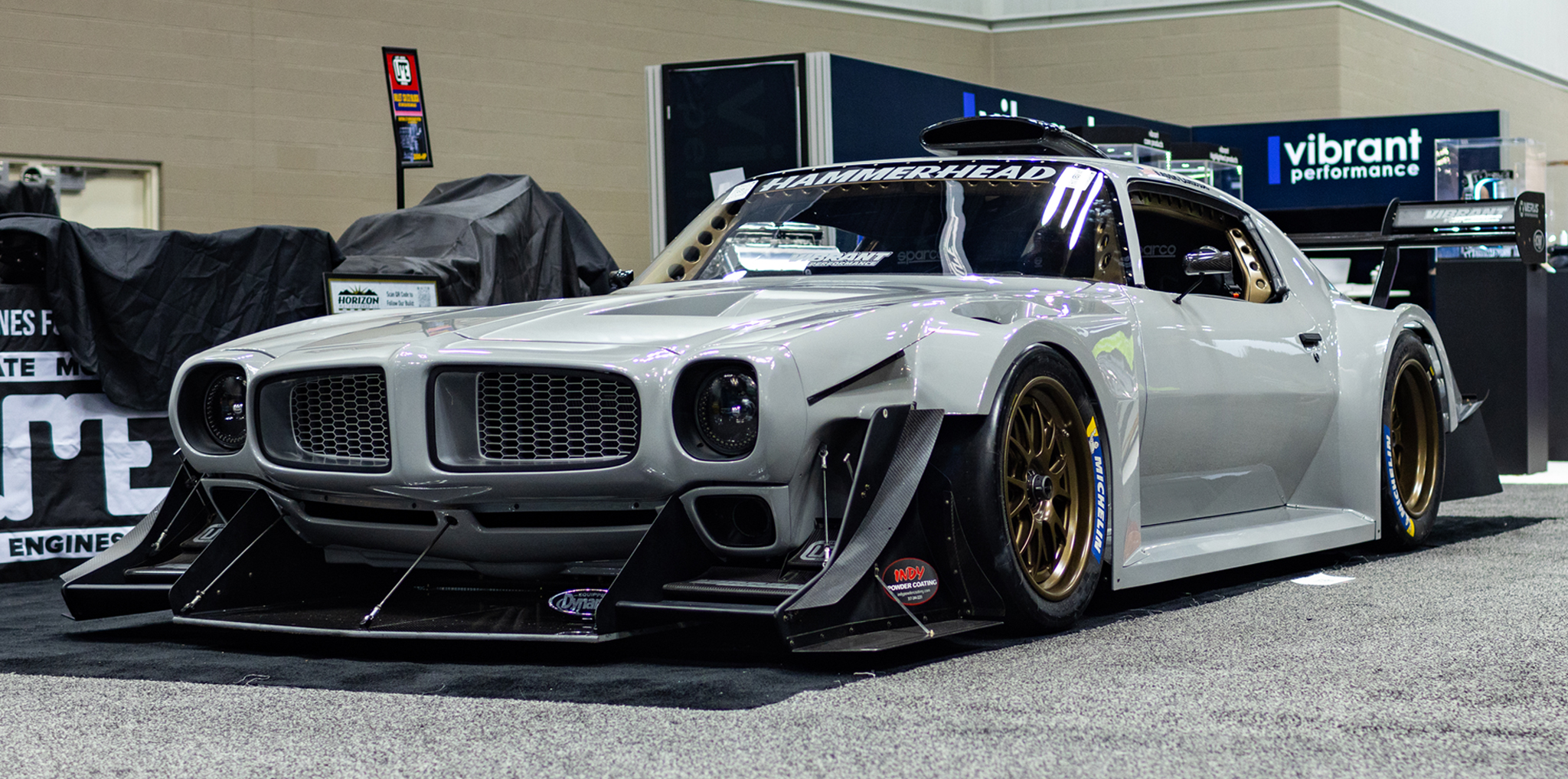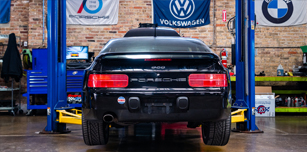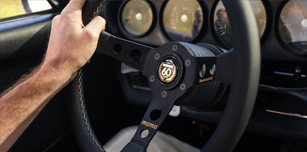- A 1973 Pontiac Trans Am served as the canvas for Russell and Cavan Cameron, a father-son duo, to build the ultimate time attack racer.
- Cavan’s requirement for a school internship was the perfect excuse to leverage Russell’s decades of IndyCar experience and accrued parts.
- Together, their limitless imaginations created “Hammerhead”, a tube-frame, 2000hp twin-turbo LSR powered Trans Am with trick aero and pushrod suspension.
- The Vibrant Performance catalog—from intake, exhaust, fuel delivery, and turbos—was instrumental in helping the Cameron team at Horizon Motorsports execute its vision.
Ask any kid what they want to be when they grow up and you’ll likely get back hundreds of different answers. Ask a new parent, and they’ll probably give you one, consistent truth: that they’d relinquish everything to help make their kids’ dreams, however farfetched, come true. These innocent dreams may have started with a sketch, or in my case, a repurposed set of couch cushions that would act as my race car. They aren’t always something that all of us are fortunate enough to pursue, but there are rare occasions when all the stars align to create one hell of a story.
I was fortunate to jump on the phone with Russell Cameron, the owner of Horizon Motorsports, renowned designer, and race car builder, after a brief conversation at PRI.
A FATHER’S JOURNEY
Russell Cameron, by every sense of the word, was a gearhead from the very beginning. What began as a necessity to repair engines on the family horse ranch, soon transformed into a passion for performance. That tinkering curiosity eventually transferred into cars and led Russell to strike a defined path toward working in motorsport. At this point, the story resonates with many of our journeys, highlighted by an important recognition of what makes us tick and a desire to align that acknowledgment with opportunities in the racing industry. But as Russell’s tenure in motorsport continued, he’d distinguish himself further from mere ambition and into realized success. His resume would tout experience with some of the most notable IndyCar and CART teams—Patrick Racing, Galles Racing, Target Chip Ganassi Racing, and PacWest Racing—himself ascending from race mechanic to director of race operations and general manager alongside establishing his own company: Horizon Motorsports.
While most race team names carried homages to the owner, Russell wanted to strike a different tone in the paddock, The team moniker was meant to recognize the dawn of a new era for Russell and his squad. When he decided to leave professional racing in 2003, Russell took the name with him, folding custom vehicle design and component manufacturing into his company’s existing motorsport acumen. Intentional or not, the one-stop-shop approach of Horizon Motorsports would lay the foundation for Russell’s most trusted teammate: his son.
A RISING STAR
While his dad cut his teeth on farm equipment, Cavan’s curiosities were piqued while sitting in race cars. Horizon Motorsport allowed Cavan to indulge that inquisitiveness without barriers; even before he could drive, he worked with Russell on several custom builds and confirmed that he, like his father, wanted to understand how to make cars go faster. “It’s a rare thing that a father can do this with his son,” qualified Russell. “We were able to leverage so much of my IndyCar experience—the facilities, tools, skills, and relationships—as well as being able to weld and learn fabrication from some of the best. Cavan progressed in such an accelerated way.”
While this could have easily just become a simple story of a son following his father’s footsteps, a high school senior internship requirement provided a unique opportunity that would not only allow Russell and Cavan to collaborate but in many ways, show how his son’s modern builder approach would catapult his career forward—long before Cavan set foot on a university campus.
SCRATCH TO ITCH
Russell and Cavan were originally working on a 1932 Ford six months before the internship. It’s a project that continues today, but the pair pivoted for the school’s obligations because of Cavan’s proportions. The constraint was fortuitous and allowed the pair to hunt for one of Russell’s long-lost favorites: a Firebird Trans Am. “I had a 1967 Chevelle Super Sport when I turned 16, but I really wanted a new Trans Am,” confessed Russell. “It looked like a custom car with that smoking chicken on the hood. I’ve had many through the years, but the 1970 Trans Am left a huge impression on me and I’ve always wanted another.” They ended up finding this car on eBay in Michigan. It wasn’t the cleanest example—it’d been drag-raced and had plenty of rust—but Russell and Cavan knew not much of the original car would remain. By the time they were done, only the roof, the top of the rear quarters, the cowl, and the VIN were the only factory pieces left.
BATMAN AND ROBIN
The Trans Am’s mod list has been long documented since its SEMA 2023 debut with Vibrant Performance, but I knew there was a bigger story than the car itself. Even though Russell has seen Cavan’s proficiencies grow exponentially before, this project would build another layer to his son’s learning, maturity, and motorsport passion. Russell admits that he purposefully committed to sustaining a two-way communication channel with Cavan, both as a co-working pair and as father and son. The duality of that relationship was rewarding and the freedom of thought helped give Cavan confidence. “He might not have understood where suspension components should go or packaging constraints out of the gate,” Russell told us. “I’d produce parts and ask Cavan for feedback and he’d revise or revisit entire sections of the car. It was a cool back and forth that helped Cavan communicate more effectively.”
The accelerated discovery helped evolve the project into what it is today. Cavan’s proficiency in SolidWorks and manufacturing relationship with Verus Engineering helped turn his design into reality. As components became decidedly better, it affected the rest of the car’s evolution. The junkyard-sourced LS was booted in favor of a high-revving (9,000rpm), twin-turbo LSR from Late Model Engines. The more potent powerplant was paired with a 2001 IndyCar drivetrain for good measure.
RISING TO CHALLENGES
Still, passion and talent are rarely enough to propel titanic builds forward. It was here that Cavan’s social media initiative shone. He asked his dad if he could start a Horizon Motorsports Instagram page to document the Trans Am build, but like everything else that Cavan touches, he devoted a seemingly endless amount of energy to make sure the social media tool worked for them. “I remember we met Art from Vibrant Performance when we had 1,000 followers,” recalled Russell. “He loved the entire story behind what we were trying to do and he was in. That really kicked everything off for us and 1.5 years later, we’ve accrued over 100,000 followers.” The extra clout has helped Horizon Motorsports attract 32 sponsors to date, including Garrett, Sparco, Radium Engineering, Antigravity Batteries, K&N, and more.
More than industry support, Russell and Cavan were hellbent on creating something that’d never been done before. This isn’t easy on a car that’s been around for over 50 years, but the challenge didn’t deter either of them from moving forward. “Engineering is all about challenges. If we were going to do it like it’d been done before, it wouldn’t have helped Cavan’s growth,” confessed Russell. To that end, the pair bravely elected to push the engine aft a mind-boggling 28” and the driver and passenger seats back eight inches, all in the name of achieving a more favorable 47/53% weight distribution. It was within this exercise that Vibrant Performance’s component catalog proved vital. It’s almost impossible to look at any given section of Hammerhead that didn’t have Vibrant’s influence.
The body itself was unlike any other, too. Cavan was largely tasked with boldly reimagining the Trans Am’s proportions, eventually having his vision realized in 3D with help from Adry 53 Customs and aero validated by Verus Engineering. There isn’t a piece on this car—even the carbon fiber roof scoop—that fails to contribute real-world functionality to the car’s time attack aims.
WHAT MATTERS MOST
Despite everything that the car has become and achieved already, Russell will be the first to tell you that the best part of the build was the time he spent with his son. It’s a testament to nurturing young talent knowing that, one day, they’ll be the ones running the show. Cavan’s exponential growth as a human being parallels the notoriety he’s rightfully earned from this Hammerhead project. And because of his dad’s mentorship, we can be sure this won’t be the last we see from the Cameron family. The Hammerhead journey isn’t finished either. It’s been a whirlwind project over the last two years, but Russell and Cavan intend to put this car through its pace on the circuit where it belongs.
Before I left Russell, I asked him if there was any advice he could leave us with and it was this: “Stay curious, ask questions, be humble. Listen as much as you talk. Racing is full of people who think they know everything.” Looking at Hammerhead, I could vividly make out where each one of those valuable lessons affected the car’s realization. It has, in so many ways, helped reset the benchmark for what the industry should expect from future builders.


















